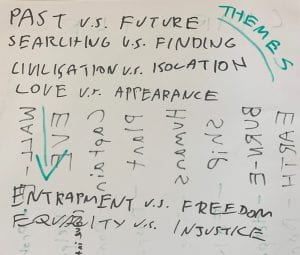As class we learnt about and discussed narrative structures, the narrative purposes of characters, themes, the significance of setting to a story and the role of the narrator in highlighting key themes. My partner and I chose to explore this topic through the Pixar film WALL-E, and situated below is, in order of right to left: A poster outlining the narrative structure of WALL-E, a summarisation of the key themes of the film, and an analysis of the characters and their narrative purpose.
In Summary – The Narrative Structure:
- The film follows the traditional three act narrative structure.
- It begins with Wall-E in his ‘ordinary world’, or equilibrium, which in the film is a future version of Earth that has been overrun by waste and junk, and is no longer inhabitable to humans or plants, just robots.
- The living seedling that Wall-E finds acts a disruption to his known world, as he sees a glimpse of both what the Earth used to be, and what it could be again if he takes action. This prompts Wall-E to travel with his new companion EVE to the spaceship in hopes of getting the plant to the captain, which acts as his quest.
- After causing disruption on the ship and driving EVE away, WALL-E faces his narrative realisation, or epiphany, in the ‘dance in space’ celebration sequence, as he simultaneously comes to the two conclusions that 1) he truly loves EVE and 2) that there is more to life than being a rubbish-collecting robot.
- After his realisation he faces many struggles, such as: having his circuits fried; being thrown down the garbage chute; and, at the climax of the film, ultimately sacrificing his life to help the Captain McCrea defeat the mutinying robots and put the plant in the Holo-Detector.
- His sacrifice could also be interpreted as his WALL-E goes through both a narrative restoration, as he returns to Earth, and a literal restoration when he is repaired by EVE and has his memory restored by her kiss. Earth was WALL-E’s ordinary world from the start of the film, but it is now transformed into a paradise by the humans inspired by WALL-E and EVE’s actions, thus also showing the transformation of him as a character.
In Summary – The Characters:
- WALL-E is unique, in that it doesn’t actually focus on a large cast of characters. Instead, it offers the narrative purpose often associated to archetypal characters to objects and settings, or has one character fulfil multiple narrative purposes.
- It is clear that WALL-E is the protagonist, as both the hero and the titular character.
- The antagonists of the film could be GO-4, AUTO or BnL as a company, or all three, as they all act as opposing forces to the antagonist.
- EVE is interesting, because it could be argued that she is: a helper, as she is WALL-E’s companion throughout the film; the girl, as she acts as WALL-E’s love interest; or as a donor, because she aids WALL-E, offering him advice, love and support.
- The role of the donor could also belong to Captain McCrea, as he helps WALL-E throughout the narrative but ascends past the role of the standard helper by ultimately winning the final fight against the antagonistic AUTO.
- We said that the ship that the humans have devolved on could act as a false hero narratively, as WALL-E initially sees it as a grand new world, but eventually realises it is the ships overbearing catering and complete automation that has doomed the human race. This could be an example of WALL-E assigning narrative traits to inanimate objects and settings.
- Another example of the film doing this that we discussed would be the role of the dispatcher, which we said could be assigned to either the plant or planet Earth. The argument for the plant was weaker, as it is clearly meant to be the disruption in the narrative rather than the dispatcher, but it is what sends WALL-E on his quest to the new world. Contrastingly, we said that the Earth itself might have been the real dispatcher, as it produced the plant, and therefore the disruption that sets the later narrative in motion.
- Finally, we thought it that BURN-E’s purpose was to be a helper, as he is the closest thing the protagonist has to a clear sidekick. He doesn’t contribute much to driving the narrative forward, but is along for the journey nonetheless.
In Summary – The Themes:
- I believe that the three most significant themes in WALL-E are the battles between: the past and the future, civilisation and isolation, and entrapment and freedom. WALL-E, as the last functioning robot on Earth, is the last bastion of the old world, and ultimately the past. Therefore, all of his conflict against the pacified humans and mutinying robots is a direct conflict against the future, and in the end of the film the characters use the fruits of the old world, in this case the plant, to build a better, new world for the future: the new paradise on Earth.
- However, during this main thematic clash, other important themes are explored, such as the aforementioned two. Our protagonist is fighting to free the humans from their entrapment at the hands of technology, and while doing this leaves his isolated world to enter civilisation and in the end restore it on Earth,



Be First to Comment